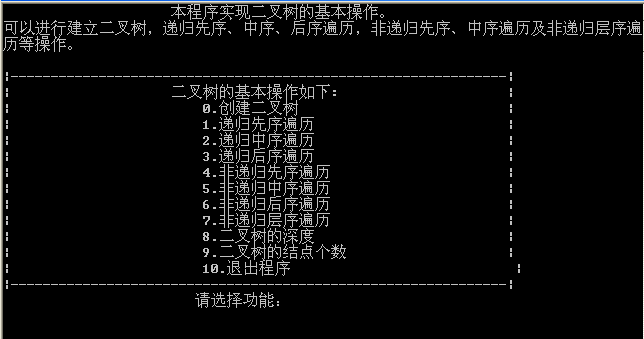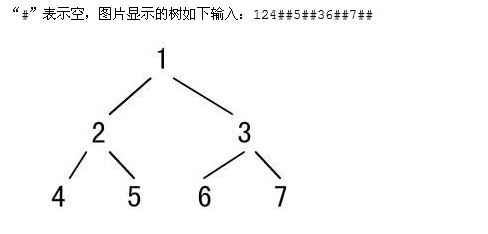е…ҲдҪҝз”Ёе…ҲеәҸзҡ„ж–№жі•е»әз«ӢдёҖжЈөдәҢеҸүж ‘пјҢ然еҗҺеҲҶеҲ«дҪҝз”ЁйҖ’еҪ’дёҺйқһйҖ’еҪ’зҡ„ж–№жі•е®һзҺ°еүҚеәҸгҖҒдёӯеәҸгҖҒеҗҺеәҸйҒҚеҺҶдәҢеҸүж ‘пјҢ并дҪҝз”ЁдәҶдёӨз§Қж–№жі•жқҘиҝӣиЎҢеұӮж¬ЎйҒҚеҺҶдәҢеҸүж ‘пјҢдёҖз§Қж–№жі•е°ұжҳҜдҪҝз”ЁSTLдёӯзҡ„queueпјҢеҸҰеӨ–дёҖз§Қж–№жі•е°ұжҳҜе®ҡд№үдәҶдёҖдёӘж•°з»„йҳҹеҲ—пјҢеҲҶеҲ«дҪҝз”ЁдәҶfrontе’ҢrearдёӨдёӘж•°з»„зҡ„дёӢж ҮжқҘиЎЁзӨәе…ҘйҳҹдёҺеҮәйҳҹпјҢиҝҳжңүдёӨдёӘж“ҚдҪңе°ұжҳҜжұӮдәҢеҸүж ‘зҡ„ж·ұеәҰгҖҒз»“зӮ№ж•°гҖӮгҖӮгҖӮ
#include "iostream"
#include "queue"
#include "stack"
using namespace std;
//дәҢеҸүж ‘з»“зӮ№зҡ„жҸҸиҝ°
typedef struct BiTNode
{
char data;
struct BiTNode *lchild, *rchild; //е·ҰеҸіеӯ©еӯҗ
}BiTNode,*BiTree;
//жҢүе…ҲеәҸйҒҚеҺҶеҲӣе»әдәҢеҸүж ‘
//BiTree *CreateBiTree() //иҝ”еӣһз»“зӮ№жҢҮй’Ҳзұ»еһӢ
//void CreateBiTree(BiTree &root) //еј•з”Ёзұ»еһӢзҡ„еҸӮж•°
void CreateBiTree(BiTNode **root) //дәҢзә§жҢҮй’ҲдҪңдёәеҮҪж•°еҸӮж•°
{
char ch; //иҰҒжҸ’е…Ҙзҡ„ж•°жҚ®
scanf("\n%c", &ch);
//cin>>ch;
if(ch=='#')
*root = NULL;
else
{
*root = (BiTNode *)malloc(sizeof(BiTNode));
(*root)->data = ch;
printf("иҜ·иҫ“е…Ҙ%cзҡ„е·Ұеӯ©еӯҗпјҡ",ch);
CreateBiTree(&((*root)->lchild));
printf("иҜ·иҫ“е…Ҙ%cзҡ„еҸіеӯ©еӯҗпјҡ",ch);
CreateBiTree(&((*root)->rchild));
}
}
//еүҚеәҸйҒҚеҺҶзҡ„з®—жі•зЁӢеәҸ
void PreOrder(BiTNode *root)
{
if(root==NULL)
return ;
printf("%c ", root->data); //иҫ“еҮәж•°жҚ®
PreOrder(root->lchild); //йҖ’еҪ’и°ғз”ЁпјҢеүҚеәҸйҒҚеҺҶе·Ұеӯҗж ‘
PreOrder(root->rchild); //йҖ’еҪ’и°ғз”ЁпјҢеүҚеәҸйҒҚеҺҶеҸіеӯҗж ‘
}
//дёӯеәҸйҒҚеҺҶзҡ„з®—жі•зЁӢеәҸ
void InOrder(BiTNode *root)
{
if(root==NULL)
return ;
InOrder(root->lchild); //йҖ’еҪ’и°ғз”ЁпјҢеүҚеәҸйҒҚеҺҶе·Ұеӯҗж ‘
printf("%c ", root->data); //иҫ“еҮәж•°жҚ®
InOrder(root->rchild); //йҖ’еҪ’и°ғз”ЁпјҢеүҚеәҸйҒҚеҺҶеҸіеӯҗж ‘
}
//еҗҺеәҸйҒҚеҺҶзҡ„з®—жі•зЁӢеәҸ
void PostOrder(BiTNode *root)
{
if(root==NULL)
return ;
PostOrder(root->lchild); //йҖ’еҪ’и°ғз”ЁпјҢеүҚеәҸйҒҚеҺҶе·Ұеӯҗж ‘
PostOrder(root->rchild); //йҖ’еҪ’и°ғз”ЁпјҢеүҚеәҸйҒҚеҺҶеҸіеӯҗж ‘
printf("%c ", root->data); //иҫ“еҮәж•°жҚ®
}
void PreOrder_Nonrecursive(BiTree T) //е…ҲеәҸйҒҚеҺҶзҡ„йқһйҖ’еҪ’
{
stack<BiTree> S;
BiTree p;
S.push(T); //ж №жҢҮй’Ҳиҝӣж Ҳ
while(!S.empty()) //ж Ҳз©әж—¶з»“жқҹ
{
while((p=S.top()) && p)
{
cout<<p->data<<" ";
S.push(p->lchild);
} //еҗ‘е·Ұиө°еҲ°е°ҪеӨҙ
S.pop(); //еј№еҮәе Ҷж Ҳ
if(!S.empty())
{
p=S.top();
S.pop();
S.push(p->rchild); //еҗ‘еҸіиө°дёҖжӯҘ
}
}
}
void InOrderTraverse(BiTree T) //дёӯеәҸйҒҚеҺҶзҡ„йқһйҖ’еҪ’
{
stack<BiTree> S;
BiTree p;
S.push(T); //ж №жҢҮй’Ҳиҝӣж Ҳ
while(!S.empty())
{
while((p=S.top()) && p)
S.push(p->lchild); //еҗ‘е·Ұиө°еҲ°е°ҪеӨҙ
S.pop(); //з©әжҢҮй’ҲйҖҖж Ҳ
if(!S.empty())
{
p=S.top();
S.pop();
cout<<p->data<<" ";
S.push(p->rchild);
}
}
}
void PostOrder_Nonrecursive(BiTree T) //еҗҺеәҸйҒҚеҺҶзҡ„йқһйҖ’еҪ’
{
stack<BiTree> S;
BiTree p=T,q=NULL;
while(p!=NULL || !S.empty()) //ж Ҳз©әж—¶з»“жқҹ
{
while(p!=NULL)
{
S.push(p);
p=p->lchild;
}
p=S.top();
if(p->rchild==NULL || p->rchild==q)
{
cout<<p->data<<" ";
q=S.top();
S.pop();
p=NULL;
}
else
p=p->rchild;
}
}
int visit(BiTree T)
{
if(T)
{
printf("%c ",T->data);
return 1;
}
else
return 0;
}
void LeverTraverse(BiTree T) //ж–№жі•дёҖгҖҒйқһйҖ’еҪ’еұӮж¬ЎйҒҚеҺҶдәҢеҸүж ‘
{
queue <BiTree> Q;
BiTree p;
p = T;
if(visit(p)==1)
Q.push(p);
while(!Q.empty())
{
p = Q.front();
Q.pop();
if(visit(p->lchild) == 1)
Q.push(p->lchild);
if(visit(p->rchild) == 1)
Q.push(p->rchild);
}
}
void LevelOrder(BiTree BT) //ж–№жі•дәҢгҖҒйқһйҖ’еҪ’еұӮж¬ЎйҒҚеҺҶдәҢеҸүж ‘
{
BiTNode *queue[10];//е®ҡд№үйҳҹеҲ—жңүеҚҒдёӘз©әй—ҙ
if (BT==NULL)
return;
int front,rear;
front=rear=0;
queue[rear++]=BT;
while(front!=rear)//еҰӮжһңйҳҹе°ҫжҢҮй’ҲдёҚзӯүдәҺеҜ№еӨҙжҢҮй’Ҳж—¶
{
cout<<queue[front]->data<<" "; //иҫ“еҮәйҒҚеҺҶз»“жһң
if(queue[front]->lchild!=NULL) //е°ҶйҳҹйҰ–з»“зӮ№зҡ„е·Ұеӯ©еӯҗжҢҮй’Ҳе…ҘйҳҹеҲ—
{
queue[rear]=queue[front]->lchild;
rear++; //йҳҹе°ҫжҢҮй’ҲеҗҺ移дёҖдҪҚ
}
if(queue[front]->rchild!=NULL)
{
queue[rear]=queue[front]->rchild; //е°ҶйҳҹйҰ–з»“зӮ№зҡ„еҸіеӯ©еӯҗжҢҮй’Ҳе…ҘйҳҹеҲ—
rear++; //йҳҹе°ҫжҢҮй’ҲеҗҺ移дёҖдҪҚ
}
front++; //еҜ№еӨҙжҢҮй’ҲеҗҺ移дёҖдҪҚ
}
}
int depth(BiTNode *T) //ж ‘зҡ„ж·ұеәҰ
{
if(!T)
return 0;
int d1,d2;
d1=depth(T->lchild);
d2=depth(T->rchild);
return (d1>d2?d1:d2)+1;
//return (depth(T->lchild)>depth(T->rchild)?depth(T->lchild):depth(T->rchild))+1;
}
int CountNode(BiTNode *T)
{
if(T == NULL)
return 0;
return 1+CountNode(T->lchild)+CountNode(T->rchild);
}
int main(void)
{
BiTNode *root=NULL; //е®ҡд№үдёҖдёӘж №з»“зӮ№
int flag=1,k;
printf(" жң¬зЁӢеәҸе®һзҺ°дәҢеҸүж ‘зҡ„еҹәжң¬ж“ҚдҪңгҖӮ\n");
printf("еҸҜд»ҘиҝӣиЎҢе»әз«ӢдәҢеҸүж ‘пјҢйҖ’еҪ’е…ҲеәҸгҖҒдёӯеәҸгҖҒеҗҺеәҸйҒҚеҺҶпјҢйқһйҖ’еҪ’е…ҲеәҸгҖҒдёӯеәҸйҒҚеҺҶеҸҠйқһйҖ’еҪ’еұӮеәҸйҒҚеҺҶзӯүж“ҚдҪңгҖӮ\n");
while(flag)
{
printf("\n");
printf("|--------------------------------------------------------------|\n");
printf("| дәҢеҸүж ‘зҡ„еҹәжң¬ж“ҚдҪңеҰӮдёӢ: |\n");
printf("| 0.еҲӣе»әдәҢеҸүж ‘ |\n");
printf("| 1.йҖ’еҪ’е…ҲеәҸйҒҚеҺҶ |\n");
printf("| 2.йҖ’еҪ’дёӯеәҸйҒҚеҺҶ |\n");
printf("| 3.йҖ’еҪ’еҗҺеәҸйҒҚеҺҶ |\n");
printf("| 4.йқһйҖ’еҪ’е…ҲеәҸйҒҚеҺҶ |\n");
printf("| 5.йқһйҖ’еҪ’дёӯеәҸйҒҚеҺҶ |\n");
printf("| 6.йқһйҖ’еҪ’еҗҺеәҸйҒҚеҺҶ |\n");
printf("| 7.йқһйҖ’еҪ’еұӮеәҸйҒҚеҺҶ |\n");
printf("| 8.дәҢеҸүж ‘зҡ„ж·ұеәҰ |\n");
printf("| 9.дәҢеҸүж ‘зҡ„з»“зӮ№дёӘж•° |\n");
printf("| 10.йҖҖеҮәзЁӢеәҸ |\n");
printf("|--------------------------------------------------------------|\n");
printf(" иҜ·йҖүжӢ©еҠҹиғҪпјҡ");
scanf("%d",&k);
switch(k)
{
case 0:
printf("иҜ·е»әз«ӢдәҢеҸүж ‘е№¶иҫ“е…ҘдәҢеҸүж ‘зҡ„ж №иҠӮзӮ№пјҡ");
CreateBiTree(&root);
break;
case 1:
if(root)
{
printf("йҖ’еҪ’е…ҲеәҸйҒҚеҺҶдәҢеҸүж ‘зҡ„з»“жһңдёәпјҡ");
PreOrder(root);
printf("\n");
}
else
printf(" дәҢеҸүж ‘дёәз©әпјҒ\n");
break;
case 2:
if(root)
{
printf("йҖ’еҪ’дёӯеәҸйҒҚеҺҶдәҢеҸүж ‘зҡ„з»“жһңдёәпјҡ");
InOrder(root);
printf("\n");
}
else
printf(" дәҢеҸүж ‘дёәз©әпјҒ\n");
break;
case 3:
if(root)
{
printf("йҖ’еҪ’еҗҺеәҸйҒҚеҺҶдәҢеҸүж ‘зҡ„з»“жһңдёәпјҡ");
PostOrder(root);
printf("\n");
}
else
printf(" дәҢеҸүж ‘дёәз©әпјҒ\n");
break;
case 4:
if(root)
{
printf("йқһйҖ’еҪ’е…ҲеәҸйҒҚеҺҶдәҢеҸүж ‘пјҡ");
PreOrder_Nonrecursive(root);
printf("\n");
}
else
printf(" дәҢеҸүж ‘дёәз©әпјҒ\n");
break;
case 5:
if(root)
{
printf("йқһйҖ’еҪ’дёӯеәҸйҒҚеҺҶдәҢеҸүж ‘пјҡ");
InOrderTraverse(root);
printf("\n");
}
else
printf(" дәҢеҸүж ‘дёәз©әпјҒ\n");
break;
case 6:
if(root)
{
printf("йқһйҖ’еҪ’еҗҺеәҸйҒҚеҺҶдәҢеҸүж ‘пјҡ");
PostOrder_Nonrecursive(root);
printf("\n");
}
else
printf(" дәҢеҸүж ‘дёәз©әпјҒ\n");
break;
case 7:
if(root)
{
printf("йқһйҖ’еҪ’еұӮеәҸйҒҚеҺҶдәҢеҸүж ‘пјҡ");
//LeverTraverse(root);
LevelOrder(root);
printf("\n");
}
else
printf(" дәҢеҸүж ‘дёәз©әпјҒ\n");
break;
case 8:
if(root)
printf("иҝҷжЈөдәҢеҸүж ‘зҡ„ж·ұеәҰдёәпјҡ%d\n",depth(root));
else
printf(" дәҢеҸүж ‘дёәз©әпјҒ\n");
break;
case 9:
if(root)
printf("иҝҷжЈөдәҢеҸүж ‘зҡ„з»“зӮ№дёӘж•°дёәпјҡ%d\n",CountNode(root));
else
printf(" дәҢеҸүж ‘дёәз©әпјҒ\n");
break;
default:
flag=0;
printf("зЁӢеәҸиҝҗиЎҢз»“жқҹпјҢжҢүд»»ж„Ҹй”®йҖҖеҮәпјҒ\n");
}
}
system("pause");
return 0;
}
иҝҗиЎҢж•ҲжһңеӣҫеҰӮдёӢпјҡ

еҲҶеҲ«иҫ“е…Ҙпјҡ
1
2
4
#
#
5
#
#
3
6
#
#
7
#
#
е°ұеҸҜд»Ҙжһ„йҖ еҰӮдёӢеӣҫжүҖзӨәзҡ„дәҢеҸүж ‘дәҶгҖӮгҖӮ

еҗҺеәҸйҒҚеҺҶйқһйҖ’еҪ’зҡ„еҸҰеӨ–дёҖз§ҚеҶҷжі•пјҡ
/*
еҗҺеәҸйҒҚеҺҶз”ұдәҺйҒҚеҺҶзҲ¶иҠӮзӮ№жҳҜеңЁйҒҚеҺҶеӯҗиҠӮзӮ№д№ӢеҗҺпјҢиҖҢдё”е·ҰиҠӮзӮ№е’ҢеҸіиҠӮзӮ№йҒҚеҺҶеҗҺзҡ„иЎҢдёәдёҚдёҖж ·пјҢ
жүҖд»ҘйңҖиҰҒз”ЁеҸҳйҮҸжқҘи®°еҪ•еүҚдёҖж¬Ўи®ҝй—®зҡ„иҠӮзӮ№пјҢж №жҚ®еүҚдёҖж¬ЎиҠӮзӮ№е’ҢзҺ°еңЁзҡ„иҠӮзӮ№зҡ„е…ізі»жқҘзЎ®е®ҡе…·дҪ“жү§иЎҢд»Җд№Ҳж“ҚдҪң
*/
void Postorder(BiTree T)
{
if(T == NULL)
return ;
stack<BiTree> s;
BiTree prev = NULL , curr = NULL;
s.push(T);
while(!s.empty())
{
curr = s.top();
if(prev == NULL || prev->lchild == curr || prev->rchild == curr)
{
if(curr->lchild != NULL)
s.push(curr->lchild);
else if(curr->rchild != NULL)
s.push(curr->rchild);
}
else if(curr->lchild == prev)
{
if(curr->rchild != NULL)
s.push(curr->rchild);
}
else
{
cout<<curr->data;
s.pop();
}
prev = curr;
}
}
иҫ“е…ҘдәҢеҸүж ‘дёӯзҡ„дёӨдёӘиҠӮзӮ№пјҢиҫ“еҮәиҝҷдёӨдёӘз»“зӮ№еңЁж•°дёӯжңҖдҪҺзҡ„е…ұеҗҢзҲ¶иҠӮзӮ№гҖӮ
жҖқи·ҜпјҡйҒҚеҺҶдәҢеҸүж ‘пјҢжүҫеҲ°дёҖжқЎд»Һж №иҠӮзӮ№ејҖе§ӢеҲ°зӣ®зҡ„иҠӮзӮ№зҡ„и·Ҝеҫ„пјҢ然еҗҺеңЁдёӨжқЎи·Ҝеҫ„дёҠжҹҘжүҫе…ұеҗҢзҡ„зҲ¶иҠӮзӮ№гҖӮ
// еҫ—еҲ°дёҖжқЎд»Һж №иҠӮзӮ№ејҖе§ӢеҲ°зӣ®зҡ„иҠӮзӮ№зҡ„и·Ҝеҫ„
bool GetNodePath(TreeNode *pRoot , TreeNode *pNode , vector<TreeNode *> &path)
{
if(pRoot == NULL)
return false;
if(pRoot == pNode)
return true;
else if(GetNodePath(pRoot->lchild , pNode , path) )
{
path.push_back(pRoot->lchild);
return true;
}
else if(GetNodePath(pRoot->rchild , pNode , path) )
{
path.push_back(pRoot->rchild);
return true;
}
return false;
}
TreeNode *GetLastCommonNode(const vector<TreeNode *> &path1 , const vector<TreeNode *> &path2)
{
vector<TreeNode *>::const_iterator iter1 = path1.begin();
vector<TreeNode *>::const_iterator iter2 = path2.begin();
TreeNode *pLast;
while(iter1 != path1.end() && iter2 != path2.end() )
{
if(*iter1 == *iter2)
pLast = *iter1;
else
break;
iter1++;
iter2++;
}
return pLast;
}
TreeNode *GetLastCommonParent(TreeNode *pRoot , TreeNode *pNode1 , TreeNode *pNode2)
{
if(pRoot == NULL || pNode1 == NULL || pNode2 == NULL)
return NULL;
vector<TreeNode *> path1;
GetNodePath(pRoot , pNode1 , path1);
vector<TreeNode *> path2;
GetNodePath(pRoot , pNode2 , path2);
return GetLastCommonNode(path1 , path2);
}
еҲҶдә«еҲ°пјҡ












зӣёе…іжҺЁиҚҗ
жҢүеұӮж¬ЎйҒҚеҺҶдәҢеҸүж ‘зҡ„з®—жі• з®ҖеҚ•жҳ“жҮӮ жҢүеұӮж¬ЎйҒҚеҺҶдәҢеҸүж ‘зҡ„з®—жі• з®ҖеҚ•жҳ“жҮӮ
жҢүеұӮж¬ЎйҒҚеҺҶдәҢеҸүж ‘пјҢз®ҖеҚ•жҳ“жҮӮпјҢж“ҚдҪңе®№жҳ“пјҢз»“жһ„жё…жҷ°пјҢиҝҗз”ЁcиҜӯиЁҖзј–зЁӢ
дәҢеҸүж ‘зҡ„ж“ҚдҪң 1.е…ҲеәҸеҲӣе»әдәҢеҸүж ‘ 2.дёӯеәҸйҖ’еҪ’йҒҚеҺҶдәҢеҸүж ‘ 3.е…ҲеәҸйқһйҖ’еҪ’йҒҚеҺҶдәҢеҸүж ‘ 4.дёӯеәҸйқһйҖ’еҪ’йҒҚеҺҶдәҢеҸүж ‘ 5.еҗҺеәҸйқһйҖ’еҪ’йҒҚеҺҶдәҢеҸүж ‘ 6.еұӮж¬ЎйҒҚеҺҶдәҢеҸүж ‘ 7.жұӮдәҢеҸүж ‘зҡ„й«ҳеәҰ 8.жұӮдәҢеҸүж ‘еҸ¶еӯҗж•° 9.йҖҖеҮәзЁӢеәҸ
ж•°жҚ®з»“жһ„е®һз”Ёж•ҷзЁӢд№ӢдәҢеҸүж ‘пјҢе…¶дёӯеҢ…еҗ«дәҶпјҡдәҢеҸүж ‘зҡ„е®ҡд№үгҖҒдәҢеҸүж ‘зҡ„йҖ’еҪ’йҒҚеҺҶгҖҒдәҢеҸүж ‘еҹәжң¬ж“ҚдҪңгҖӮ ж•°жҚ®з»“жһ„е®һз”Ёж•ҷзЁӢд№ӢдәҢеҸүж ‘пјҢе…¶дёӯеҢ…еҗ«дәҶпјҡдәҢеҸүж ‘зҡ„е®ҡд№үгҖҒдәҢеҸүж ‘зҡ„йҖ’еҪ’йҒҚеҺҶгҖҒдәҢеҸүж ‘еҹәжң¬ж“ҚдҪңгҖӮ ж•°жҚ®з»“жһ„е®һз”Ёж•ҷзЁӢд№ӢдәҢеҸүж ‘пјҢ...
е…ҲеәҸйҖ’еҪ’йҒҚеҺҶдәҢеҸүж ‘ 4.дёӯеәҸйҖ’еҪ’йҒҚеҺҶдәҢеҸүж ‘ 5.еҗҺеәҸйҖ’еҪ’йҒҚеҺҶдәҢеҸүж ‘ 6.еұӮж¬ЎйҒҚеҺҶдәҢеҸүж ‘ 7.и®Ўз®—дәҢеҸүж ‘зҡ„й«ҳеәҰ 8.и®Ўз®—дәҢеҸүж ‘дёӯеҸ¶з»“зӮ№дёӘж•° 9.дәӨжҚўдәҢеҸүж ‘зҡ„е·ҰеҸіеӯҗж ‘ 10.жү“еҚ°дәҢеҸүж ‘ 11.и®Ўз®—дәҢеҸүж ‘дёӯз»“зӮ№дёӘж•° 0.з»“жқҹзЁӢеәҸ...
е…ҲеәҸйҖ’еҪ’йҒҚеҺҶдәҢеҸүж ‘: a b c е…ҲеәҸйқһйҖ’еҪ’йҒҚеҺҶдәҢеҸүж ‘: a b c дёӯеәҸйҖ’еҪ’йҒҚеҺҶдәҢеҸүж ‘: b a c дёӯеәҸйқһйҖ’еҪ’йҒҚеҺҶдәҢеҸүж ‘: b a c еҗҺеәҸйҖ’еҪ’йҒҚеҺҶдәҢеҸүж ‘: b c a еҗҺеәҸйқһйҖ’еҪ’йҒҚеҺҶдәҢеҸүж ‘: b c a дәҢеҸүж ‘зҡ„ж·ұеәҰжҳҜ2 дәҢеҸүж ‘зҡ„з»“зӮ№дёӘж•°...
йҮҮз”ЁдәҢеҸүй“ҫиЎЁеӯҳеӮЁз»“жһ„пјҢVisitжҳҜеҜ№ж•°жҚ®е…ғзҙ ж“ҚдҪңзҡ„еә”з”ЁеҮҪж•°гҖӮ*/ /* еұӮеәҸйҒҚеҺҶдәҢеҸүж ‘Tз®—жі•(еҲ©з”ЁйҳҹеҲ—)пјҢеҜ№жҜҸдёӘж•°жҚ®е…ғзҙ и°ғз”ЁеҮҪж•°Visi
1пјҺиҫ“е…Ҙеӯ—з¬ҰеәҸеҲ—пјҢе»әз«ӢдәҢеҸүй“ҫиЎЁгҖӮ 2пјҺдёӯеәҸйҒҚеҺҶдәҢеҸүж ‘:йҖ’еҪ’з®—жі•гҖӮ 3пјҺдёӯеәҸйҒҚеҺҶдәҢеҸүж ‘:йқһйҖ’еҪ’з®—жі•гҖӮпјҲжңҖеҘҪд№ҹиғҪе®һзҺ°е…ҲеәҸпјҢеҗҺеәҸйқһйҖ’еҪ’з®—жі•пјү 4пјҺжұӮдәҢеҸүж ‘зҡ„й«ҳеәҰ гҖӮ 5пјҺжұӮдәҢеҸүж ‘зҡ„еҸ¶еӯҗдёӘж•°гҖӮ
жң¬зЁӢеәҸжҸҗдҫӣдәҶдәҢеҸүж ‘зҡ„еҗ„з§Қж“ҚдҪңпјҡеҗ„з§ҚйҒҚеҺҶпјҢеӨҚеҲ¶пјҢжұӮй«ҳеәҰпјҢеҲӨж–ӯжҳҜеҗҰдёәдёҖжЈөе®Ңе…ЁдәҢеҸүж ‘д»ҘеҸҠи®Ўз®—з”ЁдәҢеҸүж ‘еӯҳеӮЁзҡ„иЎЁиҫҫејҸ
е…ҲеәҸйҒҚеҺҶдәҢеҸүж ‘пјӣ 2.дёӯеәҸйҒҚеҺҶдәҢеҸүж ‘пјӣ3.еҗҺеәҸйҒҚеҺҶдәҢеҸүж ‘гҖӮ з®—жі•жҖқжғіпјҡ з®—жі•дёӯдё»иҰҒз”ЁеҲ°зҡ„еҮҪж•°еҰӮдёӢпјҡ гҖҖв‘ void main() //дё»еҮҪж•° гҖҖв‘Ўvoid CreatBiTree(BiTree *bt) //еҲӣе»әдәҢеҸүж ‘ гҖҖв‘ўvoid PreOrder(BiTree root) //е…ҲеәҸ...
javaиҜӯиЁҖе®һзҺ°зҡ„дәҢеҸүж ‘зҡ„еҗ„з§Қж“ҚдҪң(еҢ…жӢ¬йҖ’еҪ’дёҺйқһйҖ’еҪ’йҒҚеҺҶдәҢеҸүж ‘,жұӮдәҢеҸүж ‘зҡ„й«ҳеәҰпјҢиҠӮзӮ№жҖ»ж•°пјҢеҸ¶еӯҗиҠӮзӮ№зӯү)
дәҢеҸүж ‘зҡ„еҹәжң¬ж“ҚдҪңпјҢдҫӢеҰӮеүҚеәҸйҒҚеҺҶпјҢдёӯеәҸйҒҚеҺҶпјҢеҗҺеәҸйҒҚеҺҶеҸҠеұӮеәҸйҒҚеҺҶ
еҠҹиғҪпјҡеҲӣе»әдәҢеҸүж ‘пјӣжҢүе…ҲеәҸж¬ЎеәҸиҫ“е…ҘдәҢеҸүж ‘дёӯз»“зӮ№зҡ„еҖјпјҲеҸҜдёәеӯ—з¬ҰеһӢжҲ–ж•ҙеһӢпјҢеңЁдё»зЁӢдёӯ*/ /* е®ҡд№үпјүпјҢжһ„йҖ дәҢеҸүй“ҫиЎЁиЎЁзӨәзҡ„дәҢеҸүж ‘TгҖӮеҸҳйҮҸNil иЎЁзӨәз©әпјҲеӯҗпјүж ‘гҖӮ ж №жҚ®дёҚеҗҢзҡ„иҝҗз®—з¬ҰеҜ№ж•°жҚ®иҝӣиЎҢи®Ўз®—
е…ҲеәҸгҖҒдёӯеәҸгҖҒеҗҺеәҸйҒҚеҺҶдәҢеҸүж ‘(йҖ’еҪ’з®—жі•)!;3.дёӯеәҸйҒҚеҺҶдәҢеҸүж ‘(йқһйҖ’еҪ’з®—жі•)!жұӮдәҢеҸүж ‘зҡ„й«ҳеәҰ!жұӮдәҢеҸүж ‘зҡ„еҸ¶еӯҗдёӘж•°!;еҜ№дәҺж ‘дёӯжҜҸдёҖдёӘе…ғзҙ еҖјдёәxзҡ„з»“зӮ№пјҢеҲ еҺ»д»Ҙе®ғдёәж №зҡ„еӯҗж ‘пјҢ并йҮҠж”ҫзӣёеә”зҡ„з©әй—ҙ!еҖҹеҠ©йҳҹеҲ—е®һзҺ°дәҢеҸүж ‘зҡ„еұӮж¬ЎйҒҚеҺҶ!
并дҪҝз”ЁдәҶдёӨз§Қж–№жі•жқҘиҝӣиЎҢеұӮж¬ЎйҒҚеҺҶдәҢеҸүж ‘пјҢдёҖз§Қж–№жі•е°ұжҳҜдҪҝз”ЁSTLдёӯзҡ„queueпјҢеҸҰеӨ–дёҖз§Қж–№жі•е°ұжҳҜе®ҡд№үдәҶдёҖдёӘж•°з»„йҳҹеҲ—пјҢеҲҶеҲ«дҪҝз”ЁдәҶfrontе’ҢrearдёӨдёӘж•°з»„зҡ„дёӢж ҮжқҘиЎЁзӨәе…ҘйҳҹдёҺеҮәйҳҹпјҢиҝҳжңүдёӨдёӘж“ҚдҪңе°ұжҳҜжұӮдәҢеҸүж ‘зҡ„ж·ұеәҰгҖҒз»“зӮ№ж•°гҖӮ...
е…ідәҺдәҢеҸүж ‘зҡ„зӣёе…іж“ҚдҪң~~~дё»иҰҒе®ҢжҲҗдәҢеҸүж ‘зҡ„дёҖдәӣ... дәҢеҸүж ‘зҡ„иҫ“еҮәдё»иҰҒжҳҜжҢүе…ҲгҖҒдёӯгҖҒеҗҺдёүдёӯиҫ“еҮәжқҘиҫ“еҮәдәҢеҸүж ‘пјҢеҸҜз”ЁйҖ’еҪ’йҒҚеҺҶдәҢеҸүж ‘жҲ–з”Ёж ҲжқҘе®ҢжҲҗйқһйҖ’еҪ’йҒҚеҺҶдәҢеҸүж ‘пјҢиҫ“еҮәж јејҸеҸҜд»ҘжҳҜд»ҘдёҖдёӘеәҸеҲ—иҫ“еҮәжҲ–з”ЁдәҢеҸүж ‘зҡ„еӣҫеҪўжҳҫзӨәиҫ“еҮәгҖӮ
1пјҺеҲӣе»әд»ҘдәҢеҸүй“ҫиЎЁдҪңеӯҳеӮЁз»“жһ„зҡ„дәҢеҸүж ‘пјӣ 2пјҺжҢүеүҚеәҸйҒҚеҺҶдәҢеҸүж ‘пјӣ 3пјҺжҢүдёӯеәҸйҒҚеҺҶдәҢеҸүж ‘пјӣ 4пјҺжҢүеҗҺеәҸйҒҚеҺҶдәҢеҸүж ‘пјӣ 5пјҺи®Ўз®—дәҢеҸүж ‘зҡ„еҚ•жһқз»“зӮ№ж•°пјӣ 6пјҺжҢүеұӮж¬ЎйҒҚеҺҶдәҢеҸүж ‘гҖӮ
//жү“еҚ°ж“ҚдҪң void Print(const unsigned int &module;); //жү“еҚ°иҠӮзӮ№дҝЎжҒҜ void PrintNode(Node *p); //еүҚеәҸйҒҚеҺҶ void PreorderPrint(Node *p); //дёӯеәҸйҒҚеҺҶ void InorderPrint(Node *p); //е№ҝеәҰдјҳе…ҲйҒҚеҺҶ void...
е®һзҺ°дәҢеҸүж ‘з»“зӮ№з»“жһ„е’ҢеҜ№дәҢеҸүж ‘зҡ„еҹәжң¬ж“ҚдҪң жҺҢжҸЎеҜ№дәҢеҸүж ‘жҜҸз§Қж“ҚдҪңзҡ„е…·дҪ“е®һзҺ°пјҢеӯҰдјҡеҲ©з”ЁйҖ’еҪ’ж–№жі•зј–еҶҷеҜ№дәҢеҸүж ‘иҝҷз§ҚйҖ’еҪ’ж•°жҚ®з»“жһ„иҝӣиЎҢеӨ„зҗҶзҡ„з®—жі•гҖӮ
е»әз«ӢдәҢеҸүж ‘зҡ„дәҢеҸүй“ҫиЎЁеӯҳеӮЁз»“жһ„е®һзҺ°д»ҘдёӢж“ҚдҪң(йҖүжӢ©е…¶дёӯзҡ„дёӨдёӘеҒҡ) (1)иҫ“еҮәдәҢеҸүж ‘ (2)е…ҲеәҸйҒҚеҺҶдәҢеҸүж ‘ (3) дёӯеәҸйҒҚеҺҶдәҢеҸүж ‘ (4)еҗҺеәҸйҒҚеҺҶдәҢеҸүж ‘ (5)еұӮж¬ЎйҒҚеҺҶдәҢеҸүж ‘